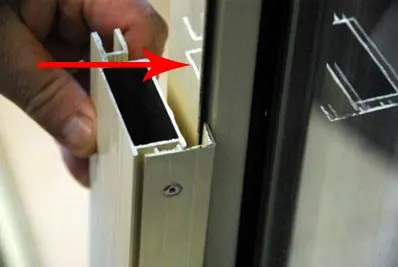What is an Interlock?
An interlock is a strip of powdercoated aluminium cut to the same length as the height of your sliding screen door. The purpose of interlocks is to lock the sliding screen door to the fixed glass panel frame at the same time as the sliding door lock engages with the latch in the receiving channel on the wall side, this ensures that the door is locked to the surrounding frame on both sides.
A frame interlock is supplied with all Seconline security rated sliding screen doors (fly screen doors and Diamond + Fly branded doors are supplied with a side bug strip only and do not require any further interlocks). The frame interlock (1.5) is fixed to the back of the sliding door at the point of installation, when the door is moved into the locked position this frame interlock will connect/interlock with the receiving interlock (1.6) which is located on the fixed glass panel.
 1.5
1.5 1.6
1.6
No Receiving Interlock?
Most, but not all fixed glass panel frames will have a receiving interlock either attached to or build in to the aluminium; if you find upon inspection that you do not have a receiving interlock there are two options available to you:
Option 1. Substitute the frame interlock for a bug seal this will eliminate insects coming from the through the gap between the door and fixed panel - indicate this change when placing your order.
Option 2. Purchase and install a receiving interlock; use the instructions below to ascertain what size receiving interlock you require and then select it from the list of Addons at Step 3 of the Product Builder.
How to select the correct receiving interlock
If you decide to purchase and install a receiving interlocks use the guide below ascertain what size receiving interlock you will require to suit your tracking then select this interlock as an Addon at Step 3 of the Product Builder.
There are three different sized receiving interlocks:
 Interlocks
InterlocksIdentifying precisely which receiving interlock is most suitable to your doors can be done using the following methods:
If the distance from the centre of the bottom track to the face edge of the fixed glass panel frame (1.7) is greater than 20 mm then a 7 mm offset interlock is required.
If the distance from the centre of the bottom track to the face edge of the fixed glass panel frame (1.7) is less than 20 mm and greater than 16 mm then a 3 mm offset interlock is required.
If the distance from the centre of the bottom track to the face edge of the fixed glass panel frame (1.7) is less than 16 mm then a flat interlock is required; if you find that you require a flat interlock you must add 10 mm to the width of each screen door.
 1.7
1.7If you are unsure if you have selected the correct receiving interlock, or if you think you may already have one, please get in touch and supply photos or a video so we can help.
 1.5
1.5 1.6
1.6 Interlocks
Interlocks 1.7
1.7